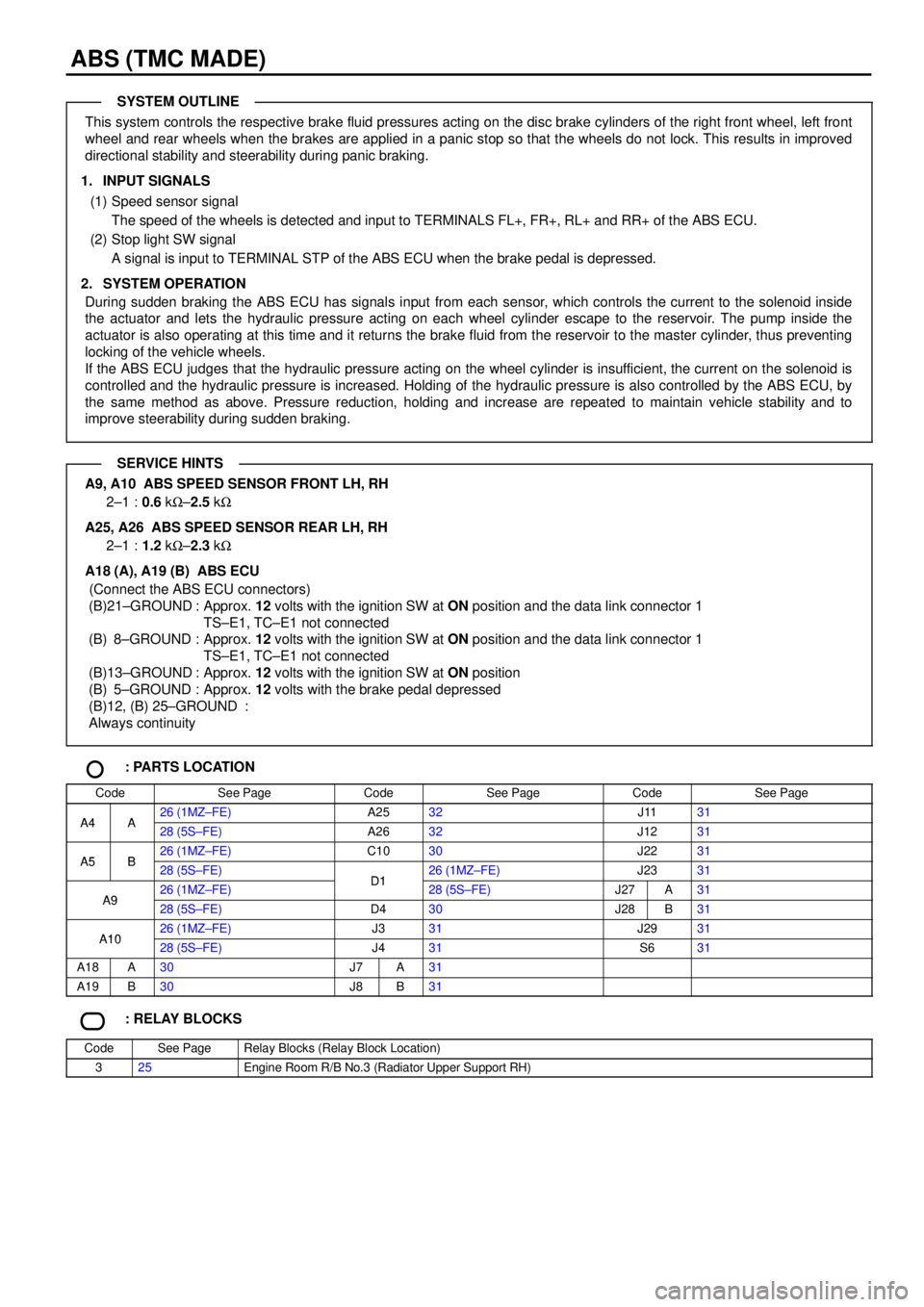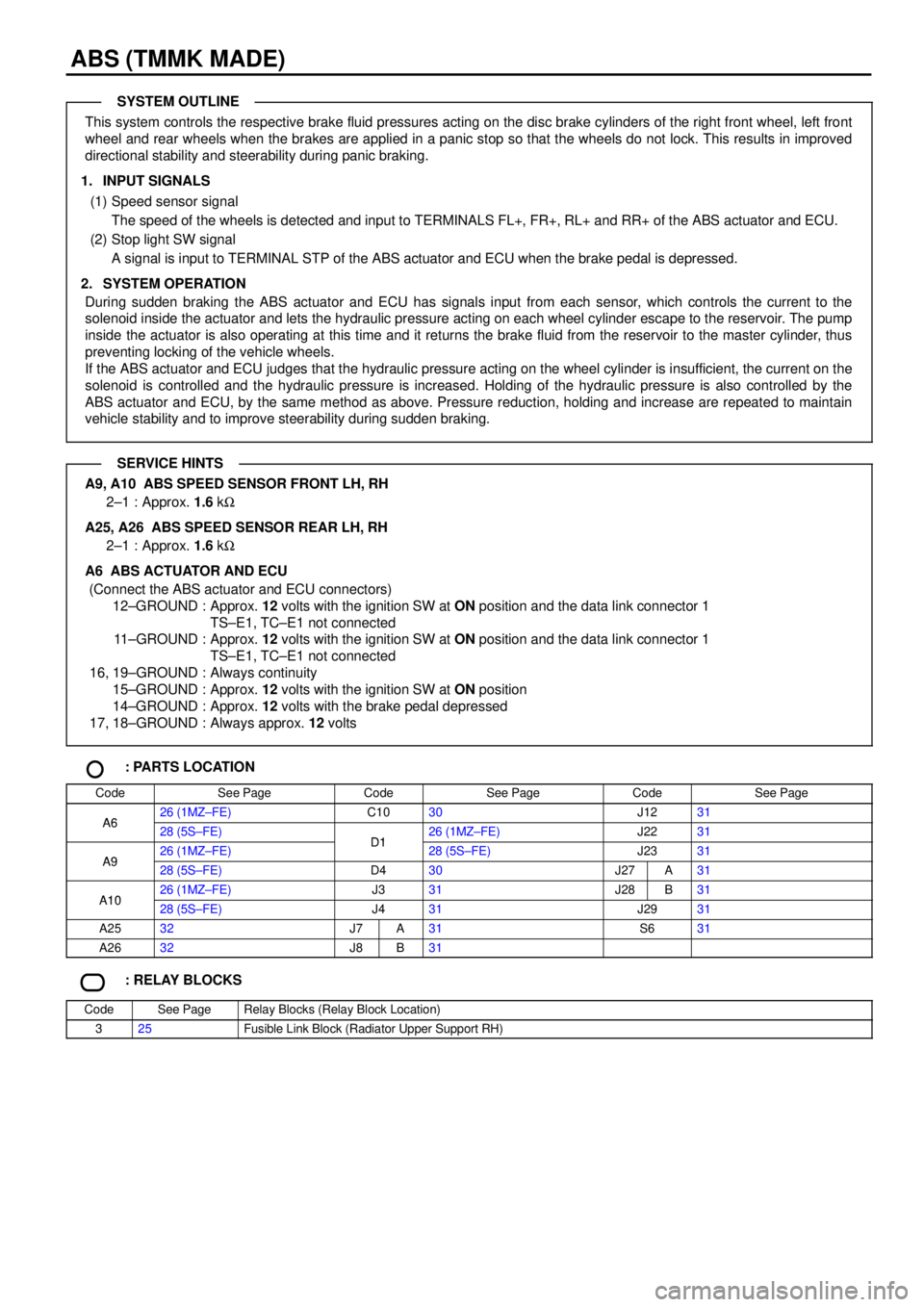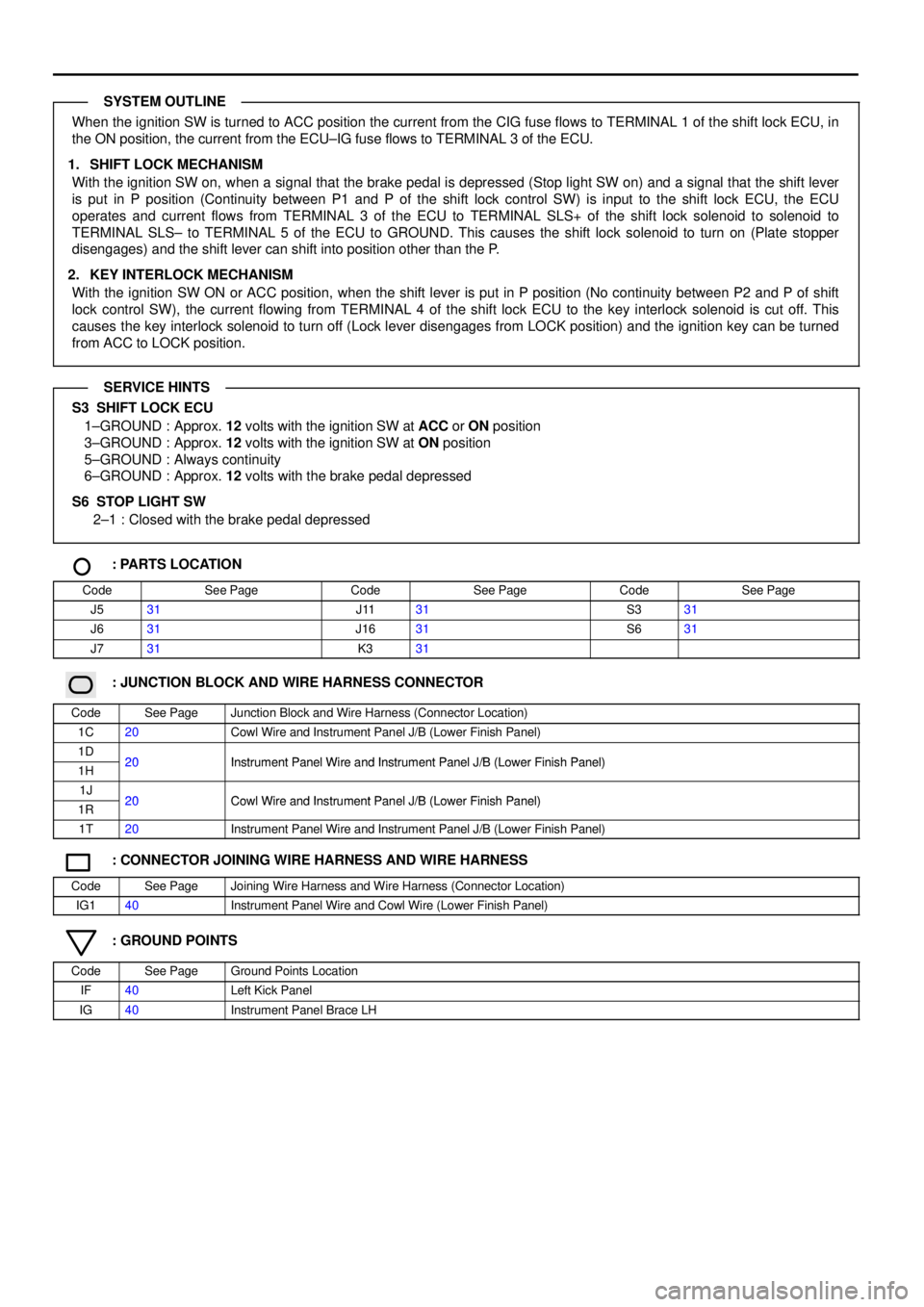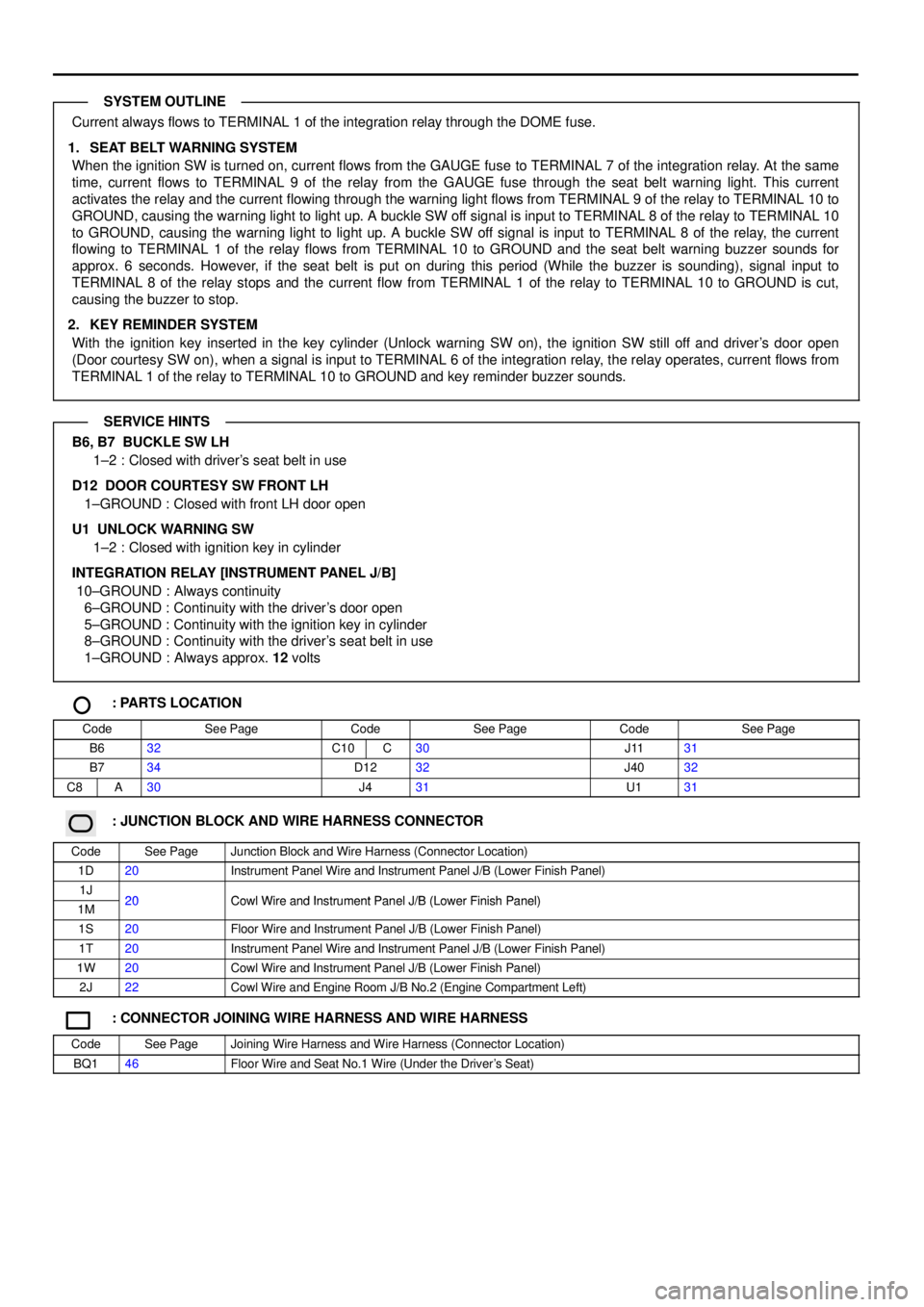2000 TOYOTA CAMRY turn signal
[x] Cancel search: turn signalPage 1360 of 4770

(5S±FE)
Previous automatic transaxle have selected each gear shift using mechanically controlled throttle hydraulic pressure,
governor hydraulic pressure and lock±up hydraulic pressure. The electronically controlled transmission, however, electrically
controls the line pressure and lock±up pressure etc., through the solenoid valve. Engine control module controls of the
solenoid valve based on the input signals from each sensor which makes smooth driving possible by shift selection for each
gear which is most appropriate to the driving conditions at that time.
1. GEAR SHIFT OPERATION
During driving, the engine control module selects the shift for each gear which is most appropriate to the driving conditions,
based on input signals from the engine coolant temp. sensor to TERMINAL THW of the engine control module, and also the
input signals to TERMINAL SPD of the engine control module from the vehicle speed sensor devoted to the electronically
controlled transmission. Current is then output to the electronically controlled transmission solenoid. When shifting to 1st
speed, current flows from TERMINAL S1 of the engine control module to TERMINAL (B) 3 of the solenoid to GROUND, and
continuity to the No.1 solenoid causes the shift.
For 2nd speed, current flows from TERMINAL S1 of the engine control module to TERMINAL (B) 3 of the solenoid to
GROUND, and from TERMINAL S2 of the engine control module to TERMINAL (B) 1 of the solenoid to GROUND, and
continuity to solenoids No.1 and No.2 causes the shift.
For 3rd speed, there is no continuity to No.1 solenoid, only to No.2, causing the shift.
Shifting into 4th speed (Overdrive) takes place when there is no continuity to either No.1 or No.2 solenoid.
2. LOCK±UP OPERATION
When the engine control module judges from each signal that lock±up operation conditions have been met, current flows
from TERMINAL SL of the engine control module to TERMINAL (A) 1 of the electronically controlled transmission solenoid to
GROUND, causing continuity to the lock±up solenoid and causing lock±up operation.
3. STOP LIGHT SW CIRCUIT
If the brake pedal is depressed (Stop light SW on) when driving in lock±up condition, a signal is input to TERMINAL STP of
the engine control module, the engine control module operates and continuity to the lock±up solenoid is cut.
4. OVERDRIVE CIRCUIT
*O/D main SW on
When the O/D main SW is turned on (O/D off indicator light turns off), a signal is input into TERMINAL OD2 of the engine
control module and engine control module operation causes gear shift when the conditions for overdrive are met.
*O/D main SW off
When the O/D main SW is turned to off, the current through the O/D off indicator light flows through the O/D main SW to
GROUND, causing the indicator light to light up. At the same time, a signal is input into TERMINAL OD2 of the engine
control module and engine control module operation prevents shift into overdrive.
E7 (A), E8 (B), E9 (C) ENGINE CONTROL MODULE (TURN ON THE IGNITION SW)
S1, S2±E1 :9.0±14.0 volts with the solenoid on
0±1.5 volts with the solenoid off
L±E1 :7.5±14.0 volts with the shift lever at L position
2±E1 :7.5±14.0 volts with the shift lever at 2 position
R±E1 :7.5±14.0 volts with the shift lever at R position
STP±E1 :9.0±14.0 volts with the brake pedal depressed
THW±E2 :0.2±1.0 volts with the engine coolant temp. 60°C (140°F) ± 120°C (248°F)
VTA±E2 :0.3±0.8 volts with the throttle valve fully closed
3.2±4.9 volts with the throttle valve fully opened
VC±E2 :4.5±5.5 volts
OD2±E1 :9.0±14.0 volts with the O/D main SW turned on
0±3.0 volts with the O/D main SW turned off
+B±E1 :9.0±14.0 volts
E3 (A), E4 (B) ELECTRONICALLY CONTROLLED TRANSMISSION SOLENOID
(A) 1, (B) 1, (B) 3±GROUND : Each 11±15 W
O2 O/D MAIN SW
2±4 : Closed with the O/D main SW off, open with the O/D main SW on
SYSTEM OUTLINE
SERVICE HINTS
Page 1367 of 4770

CRUISE CONTROL
Current is applied at all times through the STOP fuse to TERMINAL 2 of the stop light SW.
With the ignition SW turned to on, current flows through the GAUGE fuse to TERMINAL (C) 7 of the combination meter and
the current through the ECU±IG fuse flows to TERMINAL 9 of the cruise control ECU.
When the ignition SW is on and the cruise control SW is turned on, a signal is input from TERMINAL 5 of the cruise control
SW to TERMINAL 11 of the cruise control ECU. As a result, the cruise control ECU functions and the current flows from the
ECU±IG fuse to TERMINAL 9 of the cruise control ECU to TERMINAL 16 to GROUND, and the cruise control system is in a
condition ready for operation.
At the same time, the current through the GAUGE fuse flows to TERMINAL (C) 7 of the cruise control indicator light to
TERMINAL (C) 10 to TERMINAL 4 of the cruise control ECU to TERMINAL 16 to GROUND, causing the cruise control
indicator light to light up, indicating that cruise control is ready for operation.
1. SET OPERATION
When the cruise control SW is turned on and the set SW is pushed with the vehicle speed within the set limit (Approx. 40
km/h, 25 mph to 200 km/h, 124 mph), a signal is input to TERMINAL 10 of the cruise control ECU and the vehicle speed at
the time the set SW is released is memorized in the ECU as the set speed.
2. SET SPEED CONTROL
During cruise control driving, the cruise control ECU compares the set speed memorized in the cruise control ECU with the
actual vehicle speed input into TERMINAL 12 of the cruise control ECU from the speed sensor, and controls the cruise
control actuator to maintain the set speed.
When the actual speed is lower than the set speed, the ECU causes the current to the cruise control actuator to flow from
TERMINAL 15 of the cruise control ECU to TERMINAL 1 of the cruise control actuator to TERMINAL 2 to TERMINAL 7 of
the cruise control ECU. As a result, the motor in the cruise control actuator is rotated to open the than the set speed, the
current to the cruise control actuator flows from TERMINAL 7 of the cruise control ECU to TERMINAL 2 of the cruise control
actuator to TERMINAL 1 to TERMINAL 15 of the cruise control ECU.
This causes the motor in the cruise control actuator to rotate to close the throttle valve and return the throttle cable to
decrease the vehicle speed.
3. COAST CONTROL
During cruise control driving, while the coast SW is on, the cruise control actuator returns the throttle cable to close the
throttle valve and decrease the driving speed. The vehicle speed when the coast SW is turned off is memorized and the
vehicle continues at the new set speed.
4. ACCEL CONTROL
During cruise control driving, while the accel SW is turned on, the cruise control actuator pulls the throttle cable to open the
throttle valve and increase the driving speed.
The vehicle speed when the accel SW is turned off is memorized and the vehicle continues at the new set speed.
5. RESUME CONTROL
Unless the vehicle speed falls below the minimum speed limit (Approx. 40km/h, 25mph) after canceling the set speed by the
cancel SW, pushing the resume SW will cause the vehicle to resume the speed set before cancellation.
6. MANUAL CANCEL MECHANISM
If any of the following operations occurs during cruise control operation, the magnetic clutch of the actuator turns off and the
motor rotates to close the throttle valve and the cruise control is released.
*Placing the shift lever except D position (Park/Neutral position SW except D position). ºSignal is not input to TERMINAL 3
of the cruise control ECUº (A/T)
*Depressing the clutch pedal (Cruise control clutch SW off). ºSignal input to TERMINAL 3 of the cruise control ECUº (M/T)
*Depressing the brake pedal (Stop light SW on). ºSignal input to TERMINAL 2 of the cruise control ECUº
*Pushing the cancel switch (Cancel SW on). ºSignal input to TERMINAL 10 of the cruise control ECUº
*Pushing the cruise switch off ºsignal input to TERMINAL 11 of the cruise control ECUº.
SYSTEM OUTLINE
Page 1368 of 4770

7. TAP±UP CONTROL FUNCTION
When the difference between the actual vehicle speed and the set speed is less than 5 km/h (3 mph), the set speed can be
increased 1.6 km/h (1 mph) each time by operation the RESUME/ACCEL SW quickly within 0.6 seconds.
8. TAP±DOWN CONTROL FUNCTION
When the difference between the actual vehicle speed and the set speed is less than 5 km/h (3 mph), the set speed can be
lowered 1.6 km/h (1 mph) each time by operating the SET/COAST SW quickly within 0.6 seconds.
9. AUTO CANCEL FUNCTION
A) If any of the following operating conditions occurs during cruise control operation, the set speed is erased, the current
flow to the magnetic clutch is stopped and the cruise control is released. (Cruise SW turns off).
When this occurs, the ignition SW must be turned off once before the cruise SW will turn on.
*When current continued to flow to the motor inside the actuator in the throttle valve ºOPENº direction.
*The motor does not operate despite the motor drive signal being output.
B) If any of the following operating conditions occurs during cruise control operation, the set speed is erased, the current
flow to the magnetic clutch is stopped and the cruise control is released. (Cruise SW turn off).
When this occurs, the cancel state is cleared as the cruise SW will turn on again.
*Over current to transistor driving the motor and/or the magnetic clutch.
*Open circuit in the magnetic clutch.
*Momentary interruption of vehicle speed signal.
*Short circuit in the cruise control SW.
*When the vehicle speed falls more than 16 km/h (10 mph) below the set speed, E.G. on an upward slope.
C) If any of the following conditions occurs during cruise control operation, the set speed is erased and the cruise control is
released. (The power to the magnetic clutch is cut off until the set SW is ON again.)
*When the vehicle speed falls below the minimum speed limit, approx. 40 km/h (25 mph).
*When power to the cruise control system is momentarily cut off.
D) If any of the following conditions occurs during cruise control operation, the cruise control is released.
*Open the circuit for TERMINAL 2 of the stop light SW.
10. AUTOMATIC TRANSAXLE CONTROL FUNCTION
*In overdrive. If the vehicle speed becomes lower than the overdrive cut speed (Set speed minus approx. 4 km/h, 2.5 mph)
during cruise control operation, such as driving up a hill, the overdrive is released and the power increased to prevent a
reduction in vehicle speed.
*After releasing the overdrive, vehicle speed becomes higher than the overdrive return speed (Set speed minus approx. 2
km/h, 1.2 mph) and the cruise control ECU judges by the signals from the actuator's potentiometer that the upward slope
has finished, the overdrive is resumed after approximately 2 seconds.
*During cruise control driving, the cruise control operation signal is output from the cruise control ECU to the engine control
module. Upon receiving this signal, the engine control module changes the shift pattern to normal.
To maintain smooth cruise control operation (on a downward slope etc.), the lock±up release of the transmission when the
idling point of the throttle position is ON is forbidden.
C3 CRUISE CONTROL ACTUATOR
3±4 : Approx. 38.5 W
C12 CRUISE CONTROL SW [COMB. SW]
5±3 : Continuity with the CRUISE SW on
4±3 : Approx. 418 W with the CANCEL SW on
Approx. 68 W with the RESUME/ACCEL SW on
Approx. 198 W with the SET/COAST SW on
C15 CRUISE CONTROL ECU
9±GROUND :10±14 volts with the ignition SW at ON position
12±GROUND :4 pulses with 1 rotation of rotor shaft
10±GROUND : Approx. 418 W with the CANCEL SW on in the cruise control SW
Approx. 198 W with the SET/COAST SW on in the cruise control SW
Approx. 68 W with the RESUME/ACCEL SW on in the cruise control SW
16±GROUND : Always continuity
SERVICE HINTS
Page 1377 of 4770

ABS AND TRACTION CONTROL
(ABS)
ABS is a brake system designed for the purpose to improve the operating ability securing the stability of the vehicle by
preventing the looking±up of the vehicle controlling the wheel cylinder pressure of all the four wheels at the time of sudden
braking.
1. INPUT SIGNALS
(1) Speed sensor signal
The speed of the wheels is detected and input to TERMINALS FL+, FR+, RL+, and RR+ of the ABS and traction ECU.
(2) Stop light SW signal
A signal is input to TERMINAL STP of the ABS and traction ECU when brake pedal is depressed.
2. SYSTEM OPERATION
When the wheels are to be locked±up, the solenoid inside the actuator will be controlled by the signal from the ABS and
traction ECU and the brake fluid in the wheel cylinder will flow through the reservoir and reduce the hydraulic pressure.
While the ABS is in operation, as the ABS and traction ECU always outputs the operation signal to the pump inside the
actuator, brake fluid stored inside the reservoir will be suctioned up by the pump inside the actuator and returned to the
master cylinder.
When the hydraulic pressure of the wheel cylinder is decompressed or increased until the necessary hydraulic pressure, the
solenoid inside the actuator is controlled by the control signal from the ABS and traction ECU and as a result, hydraulic
pressure of the wheel cylinder will be closed at both routes of the master cylinder and reservoir sides and the hydraulic
pressure of the wheel cylinder will become to be in the holding condition.
If the increase of hydraulic pressure volume of the wheel cylinder becomes necessary, with the control signal from the ABS
and traction ECU, the solenoid inside the actuator will be controlled and become the same condition as usual and the brake
fluid of the master cylinder will be sent to the wheel cylinder and will increase the hydraulic pressure of the wheel cylinder. At
this time, in the case that the brake fluid stays left in the reservoir, it will be sucked up by the pump inside the actuator and
will be sent to the wheel cylinder.
Also, increasing speed of the hydraulic pressure is controlled by outputting the increasing and the said holding one after
another.
(Traction control)
Traction control system is designed to perform the engine output control by the fuel cut and hydraulic pressure control of
driving wheel brake and control the spinning of the driving wheels. By doing this, it improves starting acceleration and
operating ability of the vehicle securing the driving ability in accordance with the road surface condition.
3. TRACTION CONTROL OPERATION
Estimating the vehicle speed from the rear wheel speed, comparing it with the front, driving wheel speed and judging the grip
condition of the driving wheels. From the estimated vehicle speed, target speed of the driving speed will be set. When the
front, driving wheel speed exceeds the control starting speed, it judges that the tire slip is occurred and performs the fuel cut
cylinder number control and brake control and then adjust to make the front wheel speed become the traction control target
speed. Controlling of the traction control will be completed when the vehicle move onto the road where the driving wheels will
not have a tire slip or when the driver decelerate.
ABS MOTOR RELAY [R/B NO.3]
3±4 : Approx. 62 W
ABS SOL RELAY [R/B NO.3]
4±6 : Approx. 80 W
A9, A10 ABS SPEED SENSOR FRONT LH, RH
1±2 :0.6 kW±2.5 kW
A15 (A), A16 (B), A17 (C) ABS AND TRACTION ECU
(B) 8±GROUND : Approx. 12 volts with the ignition SW at ON position
(B)11±GROUND : Continuity with the ignition SW on and the traction off SW on (Traction control off)
(B)16±GROUND : Approx. 12 volts with the brake pedal depressed
(A)15, (C) 9, (C) 10±GROUND : Always continuity
A25, A26
ABS SPEED SENSOR REAR LH, RH
1±2 :1.2 kW±2.3 kW
T2 THROTTLE POSITION SENSOR
1±2 :3.5 kW±5.0 kW
SYSTEM OUTLINE
SERVICE HINTS
Page 1383 of 4770

ABS (TMC MADE)
This system controls the respective brake fluid pressures acting on the disc brake cylinders of the right front wheel, left front
wheel and rear wheels when the brakes are applied in a panic stop so that the wheels do not lock. This results in improved
directional stability and steerability during panic braking.
1. INPUT SIGNALS
(1) Speed sensor signal
The speed of the wheels is detected and input to TERMINALS FL+, FR+, RL+ and RR+ of the ABS ECU.
(2) Stop light SW signal
A signal is input to TERMINAL STP of the ABS ECU when the brake pedal is depressed.
2. SYSTEM OPERATION
During sudden braking the ABS ECU has signals input from each sensor, which controls the current to the solenoid inside
the actuator and lets the hydraulic pressure acting on each wheel cylinder escape to the reservoir. The pump inside the
actuator is also operating at this time and it returns the brake fluid from the reservoir to the master cylinder, thus preventing
locking of the vehicle wheels.
If the ABS ECU judges that the hydraulic pressure acting on the wheel cylinder is insufficient, the current on the solenoid is
controlled and the hydraulic pressure is increased. Holding of the hydraulic pressure is also controlled by the ABS ECU, by
the same method as above. Pressure reduction, holding and increase are repeated to maintain vehicle stability and to
improve steerability during sudden braking.
A9, A10 ABS SPEED SENSOR FRONT LH, RH
2±1 :0.6 kW±2.5 kW
A25, A26 ABS SPEED SENSOR REAR LH, RH
2±1 :1.2 kW±2.3 kW
A18 (A), A19 (B) ABS ECU
(Connect the ABS ECU connectors)
(B)21±GROUND : Approx. 12 volts with the ignition SW at ON position and the data link connector 1
TS±E1, TC±E1 not connected
(B) 8±GROUND : Approx. 12 volts with the ignition SW at ON position and the data link connector 1
TS±E1, TC±E1 not connected
(B)13±GROUND : Approx. 12 volts with the ignition SW at ON position
(B) 5±GROUND : Approx. 12 volts with the brake pedal depressed
(B)12, (B) 25±GROUND :
Always continuity
: PARTS LOCATION
CodeSee PageCodeSee PageCodeSee Page
A4A26 (1MZ±FE)A2532J1131A4A28 (5S±FE)A2632J1231
A5B26 (1MZ±FE)C1030J2231A5B28 (5S±FE)D126 (1MZ±FE)J2331
A926 (1MZ±FE)D128 (5S±FE)J27A31A928 (5S±FE)D430J28B31
A1026 (1MZ±FE)J331J2931A1028 (5S±FE)J431S631
A18A30J7A31
A19B30J8B31
: RELAY BLOCKS
CodeSee PageRelay Blocks (Relay Block Location)
325Engine Room R/B No.3 (Radiator Upper Support RH)
SYSTEM OUTLINE
SERVICE HINTS
Page 1389 of 4770

ABS (TMMK MADE)
This system controls the respective brake fluid pressures acting on the disc brake cylinders of the right front wheel, left front
wheel and rear wheels when the brakes are applied in a panic stop so that the wheels do not lock. This results in improved
directional stability and steerability during panic braking.
1. INPUT SIGNALS
(1) Speed sensor signal
The speed of the wheels is detected and input to TERMINALS FL+, FR+, RL+ and RR+ of the ABS actuator and ECU.
(2) Stop light SW signal
A signal is input to TERMINAL STP of the ABS actuator and ECU when the brake pedal is depressed.
2. SYSTEM OPERATION
During sudden braking the ABS actuator and ECU has signals input from each sensor, which controls the current to the
solenoid inside the actuator and lets the hydraulic pressure acting on each wheel cylinder escape to the reservoir. The pump
inside the actuator is also operating at this time and it returns the brake fluid from the reservoir to the master cylinder, thus
preventing locking of the vehicle wheels.
If the ABS actuator and ECU judges that the hydraulic pressure acting on the wheel cylinder is insufficient, the current on the
solenoid is controlled and the hydraulic pressure is increased. Holding of the hydraulic pressure is also controlled by the
ABS actuator and ECU, by the same method as above. Pressure reduction, holding and increase are repeated to maintain
vehicle stability and to improve steerability during sudden braking.
A9, A10 ABS SPEED SENSOR FRONT LH, RH
2±1 : Approx. 1.6 kW
A25, A26 ABS SPEED SENSOR REAR LH, RH
2±1 : Approx. 1.6 kW
A6 ABS ACTUATOR AND ECU
(Connect the ABS actuator and ECU connectors)
12±GROUND : Approx. 12 volts with the ignition SW at ON position and the data link connector 1
TS±E1, TC±E1 not connected
11±GROUND : Approx. 12 volts with the ignition SW at ON position and the data link connector 1
TS±E1, TC±E1 not connected
16, 19±GROUND : Always continuity
15±GROUND : Approx. 12 volts with the ignition SW at ON position
14±GROUND : Approx. 12 volts with the brake pedal depressed
17, 18±GROUND : Always approx. 12 volts
: PARTS LOCATION
CodeSee PageCodeSee PageCodeSee Page
A626 (1MZ±FE)C1030J1231A628 (5S±FE)D126 (1MZ±FE)J2231
A926 (1MZ±FE)D128 (5S±FE)J2331A928 (5S±FE)D430J27A31
A1026 (1MZ±FE)J331J28B31A1028 (5S±FE)J431J2931
A2532J7A31S631
A2632J8B31
: RELAY BLOCKS
CodeSee PageRelay Blocks (Relay Block Location)
325Fusible Link Block (Radiator Upper Support RH)
SYSTEM OUTLINE
SERVICE HINTS
Page 1400 of 4770

When the ignition SW is turned to ACC position the current from the CIG fuse flows to TERMINAL 1 of the shift lock ECU, in
the ON position, the current from the ECU±IG fuse flows to TERMINAL 3 of the ECU.
1. SHIFT LOCK MECHANISM
With the ignition SW on, when a signal that the brake pedal is depressed (Stop light SW on) and a signal that the shift lever
is put in P position (Continuity between P1 and P of the shift lock control SW) is input to the shift lock ECU, the ECU
operates and current flows from TERMINAL 3 of the ECU to TERMINAL SLS+ of the shift lock solenoid to solenoid to
TERMINAL SLS± to TERMINAL 5 of the ECU to GROUND. This causes the shift lock solenoid to turn on (Plate stopper
disengages) and the shift lever can shift into position other than the P.
2. KEY INTERLOCK MECHANISM
With the ignition SW ON or ACC position, when the shift lever is put in P position (No continuity between P2 and P of shift
lock control SW), the current flowing from TERMINAL 4 of the shift lock ECU to the key interlock solenoid is cut off. This
causes the key interlock solenoid to turn off (Lock lever disengages from LOCK position) and the ignition key can be turned
from ACC to LOCK position.
S3 SHIFT LOCK ECU
1±GROUND : Approx. 12 volts with the ignition SW at ACC or ON position
3±GROUND : Approx. 12 volts with the ignition SW at ON position
5±GROUND : Always continuity
6±GROUND : Approx. 12 volts with the brake pedal depressed
S6 STOP LIGHT SW
2±1 : Closed with the brake pedal depressed
: PARTS LOCATION
CodeSee PageCodeSee PageCodeSee Page
J531J1131S331
J631J1631S631
J731K331
: JUNCTION BLOCK AND WIRE HARNESS CONNECTOR
CodeSee PageJunction Block and Wire Harness (Connector Location)
1C20Cowl Wire and Instrument Panel J/B (Lower Finish Panel)
1D20Instrument Panel Wire and Instrument Panel J/B (Lower Finish Panel)1H20Instrument Panel Wire and Instrument Panel J/B (Lower Finish Panel)
1J20Cowl Wire and Instrument Panel J/B (Lower Finish Panel)1R20Cowl Wire and Instrument Panel J/B (Lower Finish Panel)
1T20Instrument Panel Wire and Instrument Panel J/B (Lower Finish Panel)
: CONNECTOR JOINING WIRE HARNESS AND WIRE HARNESS
CodeSee PageJoining Wire Harness and Wire Harness (Connector Location)
IG140Instrument Panel Wire and Cowl Wire (Lower Finish Panel)
: GROUND POINTS
CodeSee PageGround Points Location
IF40Left Kick Panel
IG40Instrument Panel Brace LH
SYSTEM OUTLINE
SERVICE HINTS
Page 1408 of 4770

Current always flows to TERMINAL 1 of the integration relay through the DOME fuse.
1. SEAT BELT WARNING SYSTEM
When the ignition SW is turned on, current flows from the GAUGE fuse to TERMINAL 7 of the integration relay. At the same
time, current flows to TERMINAL 9 of the relay from the GAUGE fuse through the seat belt warning light. This current
activates the relay and the current flowing through the warning light flows from TERMINAL 9 of the relay to TERMINAL 10 to
GROUND, causing the warning light to light up. A buckle SW off signal is input to TERMINAL 8 of the relay to TERMINAL 10
to GROUND, causing the warning light to light up. A buckle SW off signal is input to TERMINAL 8 of the relay, the current
flowing to TERMINAL 1 of the relay flows from TERMINAL 10 to GROUND and the seat belt warning buzzer sounds for
approx. 6 seconds. However, if the seat belt is put on during this period (While the buzzer is sounding), signal input to
TERMINAL 8 of the relay stops and the current flow from TERMINAL 1 of the relay to TERMINAL 10 to GROUND is cut,
causing the buzzer to stop.
2. KEY REMINDER SYSTEM
With the ignition key inserted in the key cylinder (Unlock warning SW on), the ignition SW still off and driver's door open
(Door courtesy SW on), when a signal is input to TERMINAL 6 of the integration relay, the relay operates, current flows from
TERMINAL 1 of the relay to TERMINAL 10 to GROUND and key reminder buzzer sounds.
B6, B7 BUCKLE SW LH
1±2 : Closed with driver's seat belt in use
D12 DOOR COURTESY SW FRONT LH
1±GROUND : Closed with front LH door open
U1 UNLOCK WARNING SW
1±2 : Closed with ignition key in cylinder
INTEGRATION RELAY [INSTRUMENT PANEL J/B]
10±GROUND : Always continuity
6±GROUND : Continuity with the driver's door open
5±GROUND : Continuity with the ignition key in cylinder
8±GROUND : Continuity with the driver's seat belt in use
1±GROUND : Always approx. 12 volts
: PARTS LOCATION
CodeSee PageCodeSee PageCodeSee Page
B632C10C30J1131
B734D1232J4032
C8A30J431U131
: JUNCTION BLOCK AND WIRE HARNESS CONNECTOR
CodeSee PageJunction Block and Wire Harness (Connector Location)
1D20Instrument Panel Wire and Instrument Panel J/B (Lower Finish Panel)
1J20Cowl Wire and Instrument Panel J/B (Lower Finish Panel)1M20Cowl Wire and Instrument Panel J/B (Lower Finish Panel)
1S20Floor Wire and Instrument Panel J/B (Lower Finish Panel)
1T20Instrument Panel Wire and Instrument Panel J/B (Lower Finish Panel)
1W20Cowl Wire and Instrument Panel J/B (Lower Finish Panel)
2J22Cowl Wire and Engine Room J/B No.2 (Engine Compartment Left)
: CONNECTOR JOINING WIRE HARNESS AND WIRE HARNESS
CodeSee PageJoining Wire Harness and Wire Harness (Connector Location)
BQ146Floor Wire and Seat No.1 Wire (Under the Driver's Seat)
SYSTEM OUTLINE
SERVICE HINTS